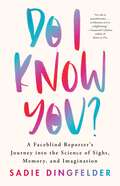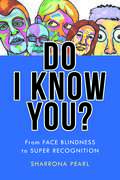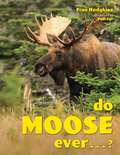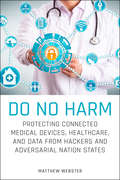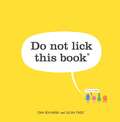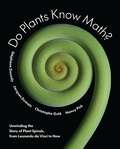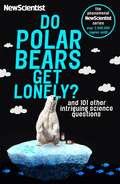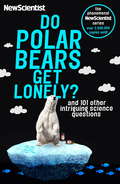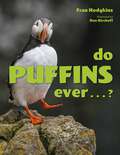- Table View
- List View
Do I Know You?: A Faceblind Reporter's Journey into the Science of Sight, Memory, and Imagination
by Sadie DingfelderAn award-winning science writer discovers she&’s faceblind and investigates the neuroscience of sight, memory, and imagination—while solving some long-running mysteries about her own life. Science writer Sadie Dingfelder has always known that she&’s a little quirky. But while she&’s made some strange mistakes over the years, it&’s not until she accosts a stranger in a grocery store (whom she thinks is her husband) that she realizes something is amiss. With a mixture of curiosity and dread, Dingfelder starts contacting neuroscientists and lands herself in scores of studies. In the course of her nerdy midlife crisis, she discovers that she is emphatically not neurotypical. She has prosopagnosia (faceblindness), stereoblindness, aphantasia (an inability to create mental imagery), and a condition called severely deficient autobiographical memory. As Dingfelder begins to see herself more clearly, she discovers a vast well of hidden neurodiversity in the world at large. There are so many different flavors of human consciousness, and most of us just assume that ours is the norm. Can you visualize? Do you have an inner monologue? Are you always 100 percent sure whether you know someone or not? If you can perform any of these mental feats, you may be surprised to learn that many people—including Dingfelder—can&’t. A lively blend of personal narrative and popular science, Do I Know You? is the story of one unusual mind&’s attempt to understand itself—and a fascinating exploration of the remarkable breadth of human experience.
Do Moose Ever . . .?
by Fran HodgkinsMoose sure are funny looking. With their rangy, gangly bodies, long legs, and confused look on their face, they are the most distinct of the deer species. Just looking at a moose will make you smile.This entertaining and informative book answers the kinds of questions kids always ask, such as:What do moose eat?Are moose dangerous?Can moose be tamed?And What&’s with those silly antlers, anyway?
Do No Harm: Protecting Connected Medical Devices, Healthcare, and Data from Hackers and Adversarial Nation States
by Matthew WebsterDiscover the security risks that accompany the widespread adoption of new medical devices and how to mitigate them In Do No Harm: Protecting Connected Medical Devices, Healthcare, and Data from Hackers and Adversarial Nation States, cybersecurity expert Matthew Webster delivers an insightful synthesis of the health benefits of the Internet of Medical Things (IoMT), the evolution of security risks that have accompanied the growth of those devices, and practical steps we can take to protect ourselves, our data, and our hospitals from harm. You’ll learn how the high barriers to entry for innovation in the field of healthcare are impeding necessary change and how innovation accessibility must be balanced against regulatory compliance and privacy to ensure safety. In this important book, the author describes: The increasing expansion of medical devices and the dark side of the high demand for medical devices The medical device regulatory landscape and the dilemmas hospitals find themselves in with respect medical devices Practical steps that individuals and businesses can take to encourage the adoption of safe and helpful medical devices or mitigate the risk of having insecure medical devices How to help individuals determine the difference between protected health information and the information from health devices--and protecting your data How to protect your health information from cell phones and applications that may push the boundaries of personal privacy Why cybercriminals can act with relative impunity against hospitals and other organizations Perfect for healthcare professionals, system administrators, and medical device researchers and developers, Do No Harm is an indispensable resource for anyone interested in the intersection of patient privacy, cybersecurity, and the world of Internet of Medical Things.
Do Not Lick This Book
by Idan Ben-BarakIn this interactive children’s picture book, microbiologist Idan Ben-Barak and award-winning illustrator Julian Frost zoom in on the microscopic world found on everyday objects—and in our bodies—warning readers Do Not Lick This Book.Min is a microbe. She is small.Very small.In fact, so small that you’d need to look through a microscope to see her. Or you can simply open this book and take Min on an adventure to amazing places she’s never seen before—like the icy glaciers of your tooth or the twisted, tangled jungle of your shirt.
Do Plants Know Math?: Unwinding the Story of Plant Spirals, from Leonardo da Vinci to Now
by Stéphane Douady Jacques Dumais Christophe Golé Nancy PickA breathtakingly illustrated look at botanical spirals and the scientists who puzzled over themCharles Darwin was driven to distraction by plant spirals, growing so exasperated that he once begged a friend to explain the mystery &“if you wish to save me from a miserable death.&” The legendary naturalist was hardly alone in feeling tormented by these patterns. Plant spirals captured the gaze of Leonardo da Vinci and became Alan Turing&’s final obsession. This book tells the stories of the physicists, mathematicians, and biologists who found themselves magnetically drawn to Fibonacci spirals in plants, seeking an answer to why these beautiful and seductive patterns occur in botanical forms as diverse as pine cones, cabbages, and sunflowers.Do Plants Know Math? takes you down through the centuries to explore how great minds have been captivated and mystified by Fibonacci patterns in nature. It presents a powerful new geometrical solution, little known outside of scientific circles, that sheds light on why regular and irregular spiral patterns occur. Along the way, the book discusses related plant geometries such as fractals and the fascinating way that leaves are folded inside of buds. Your neurons will crackle as you begin to see the connections. This book will inspire you to look at botanical patterns—and the natural world itself—with new eyes.Featuring hundreds of gorgeous color images, Do Plants Know Math? includes a dozen creative hands-on activities and even spiral-plant recipes, encouraging readers to explore and celebrate these beguiling patterns for themselves.
Do Polar Bears Get Lonely: And 101 other intriguing science questions
by New ScientistDo Polar Bears Get Lonely? is the third compilation of readers' answers to the questions in the 'Last Word' column of New Scientist, the world's best-selling science weekly. Following the phenomenal success of Does Anything Eat Wasps? (2005) and the even more spectacularly successful Why Don't Penguins' Feet Freeze? (2006), Do Polar Bears Get Lonely? includes a bumper crop of wise and wonderful questions and answers such as:Why does garlic make your breath smell? How toothpaste makers get the stripes in toothpaste? Why do we get 'pins and needles'? Why are some people left-handed and other people right-handed? Can insects get fat? Do elephants sneeze? And do fish get thirsty? What causes cells to stick together in the human body rather than simply fall apart? And why are pears pear-shaped (and not apple-shaped)?This eagerly awaited selection of the best once again presents popular science at its most entertaining and enlightening.
Do Polar Bears Get Lonely?: And 101 Other Intriguing Science Questions
by New ScientistDo Polar Bears Get Lonely? is the third compilation of readers' answers to the questions in the 'Last Word' column of New Scientist, the world's best-selling science weekly. Following the phenomenal success of Does Anything Eat Wasps? (2005) and the even more spectacularly successful Why Don't Penguins' Feet Freeze? (2006), this latest collection includes a bumper crop of wise and wonderful answers never before seen in book form.As usual, the simplest questions often have the most complex answers - while some that seem the knottiest have very simple explanations. New Scientist's 'Last Word' is regularly voted the magazine's most popular section as it celebrates all questions - the trivial, idiosyncratic, baffling and strange. This all-new and eagerly awaited selection of the best again presents popular science at its most entertaining and enlightening.
Do Polar Bears Get Lonely?: And 101 Other Intriguing Science Questions
by New ScientistDo Polar Bears Get Lonely? is the third compilation of readers' answers to the questions in the 'Last Word' column of New Scientist, the world's best-selling science weekly. Following the phenomenal success of Does Anything Eat Wasps? (2005) and the even more spectacularly successful Why Don't Penguins' Feet Freeze? (2006), this latest collection includes a bumper crop of wise and wonderful answers never before seen in book form.As usual, the simplest questions often have the most complex answers - while some that seem the knottiest have very simple explanations. New Scientist's 'Last Word' is regularly voted the magazine's most popular section as it celebrates all questions - the trivial, idiosyncratic, baffling and strange. This all-new and eagerly awaited selection of the best again presents popular science at its most entertaining and enlightening.
Do Puffins Ever . . .?
by Fran HodgkinsPuffins are funny. With their round little bodies and stubby wings, combined with a brightly colored beak, they are one of the most appealing birds. Just looking at a puffin can make you happy.This entertaining and informative book tells you everything you really want to know about puffins, answering the kinds of questions kids always ask, such as:Do puffins have teeth?Do they always have such colorful beaks?Are they related to penguins?and Why are they called puffins, anyway?
Do Robots Make Love?: From AI to Immortality – Understanding Transhumanism in 12 Questions
by Jean-Michel Besnier Laurent AlexandreShould we enhance the human condition with technology?Does anyone really want to live for a thousand years?Could AI end up destroying mankind?Discover the incredible potential of mankind's near future as Doctor and entrepreneur Laurent Alexandre and tech-philosopher Jean Michel Besnier go head to head on the big questions in an entertaining and thought-provoking debate on the fundamental principles of transhumanism.This movement seeks to improve the human condition through science - has fast become one of the most controversial the scientific community have ever faced. As great strides are made in using advanced technology to enhance human intellect and physiology, the ethical and moral questions surrounding its possibilities have never been more pressing. Should we change the way we reproduce? Could we enhance the human body with technology to the point where we are all technically cyborgs? Is it possible to make love to a robot?
Do Seals Ever . . . ?
by Fran HodgkinsA fun, informative read for kids of all agesThis entertaining and informative book gives serious answers to questions such as Do seals ever sleep?, Do they have ears?, Do seals have fur?
Do Something: Activism for Everyone
by Kajal Odedra'An indispensable manual for budding activists by one of the country's most effective campaigners.'Cathy Newman, Journalist and Presenter'Tired of complaining but don't know what to do? This beautifully written book will not only inspire you but give you a step-by-step guide to creating positive change.'Magid Magid, Politician and Activist'This is your mayday book. If you want to start your own resistance, buy Do Something.'Deborah Frances-White, Host of The Guilty Feminist podcastDo you find yourself staring helplessly at your news feed? Or all too often asking, 'why hasn't somebody done something about that?'. If the answer is yes, then DO SOMETHING is the book you need.Whether you simply want to challenge your local shop to reduce their plastic or go big and demand a new law to be passed, this book is the place to start.Full of lessons from the real world DO SOMETHING contains practical steps and a blueprint anyone can follow - from helping you to pinpoint the fundamentals of what you want to achieve to mobilising supporters and harnessing traditional and social media. Having worked as a campaigner for over a decade Kajal Odedra knows the tricks that have typically been held by people in circles of power and believes that everyone should know how to speak up and be heard. Revolution on every scale is happening all around the world - but rather than being led by governments, policy makers or political leaders, it is individuals, communities and collectives who are calling for action. People power works! So, stop banging your head against the wall, pick up this book, and start planning your resistance.
Do Something: Activism for Everyone
by Kajal Odedra'An indispensable manual for budding activists by one of the country's most effective campaigners.'Cathy Newman, Journalist and Presenter'Tired of complaining but don't know what to do? This beautifully written book will not only inspire you but give you a step-by-step guide to creating positive change.'Magid Magid, Politician and Activist'This is your mayday book. If you want to start your own resistance, buy Do Something.'Deborah Frances-White, Host of The Guilty Feminist podcastDo you find yourself staring helplessly at your news feed? Or all too often asking, 'why hasn't somebody done something about that?'. If the answer is yes, then DO SOMETHING is the book you need.Whether you simply want to challenge your local shop to reduce their plastic or go big and demand a new law to be passed, this book is the place to start.Full of lessons from the real world DO SOMETHING contains practical steps and a blueprint anyone can follow - from helping you to pinpoint the fundamentals of what you want to achieve to mobilising supporters and harnessing traditional and social media. Having worked as a campaigner for over a decade Kajal Odedra knows the tricks that have typically been held by people in circles of power and believes that everyone should know how to speak up and be heard. Revolution on every scale is happening all around the world - but rather than being led by governments, policy makers or political leaders, it is individuals, communities and collectives who are calling for action. People power works! So, stop banging your head against the wall, pick up this book, and start planning your resistance.
Do Something: Activism for Everyone
by Kajal OdedraA user's guide to Activism by one of the UK's biggest names in grass-roots campaigning shows in a few simple steps how we can all make a difference.People power works and is changing the world around us. This is a user's guide to activism by one of the UK's biggest names in grass-roots campaigning. Illustrated with lessons from the real world, it is a guide to creating change for anyone who has ever asked themselves 'why hasn't anyone done something about that?'We are taught to believe that only a small group of people in society have the ability to change laws and company policies. That's simply not true any longer - each of is capable of using our experiences to change the world. We just need to use that thing that makes us different, and learn how to channel it. Having worked as a campaigner for the last 11 years, Kajal Odedra of change.org - which is used by 15 million people in the UK - has learned the tricks of the trade that have traditionally been held in circles of power, and believes that everyone should know how to speak up and be heard. Her mission is to show people how to use their voice to make their community, politicians and CEOs take notice.(P)2019 Hodder & Stoughton Ltd
Do Sparrows Like Bach?: The Strange and Wonderful Things that Are Discovered When Scientists Break Free
by New ScientistFrom the same editors that brought you Why Don't Penguins' Feet Freeze? and Does Anything Eat Wasps?, an exploration of the weird and wonderful margins of science--the latest volume in the brilliant New Scientist series. Science tells us grand things about the universe: how fast light travels, and why stones fall to earth. But scientific endeavor goes far beyond these obvious foundations. There are some fields we don`t often hear about because they are so specialized, or turn out to be dead ends. Yet researchers have given hallucinogenic drugs to blind people (seriously), tried to weigh the soul as it departs the body, and planned to blast a new Panama Canal with an atomic weapon. Real scientific breakthroughs sometimes come out of the most surprising and unpromising work. Do Sparrows Like Bach? is about the margins of science--investigating everything from what it`s like to die to exploding pants and recycled urine. Who on earth would burn off their beard with a laser? Produce a fireproof umbrella that doubles as a parachute? Replace sniffer dogs with gerbils? Could a chemical component of flatulence be the next Viagra? Do sparrows (and even fish for that matter) prefer Bach to Led Zeppelin? The editors at New Scientist magazine have the answers to all these questions and more in this celebration of outrageous, outlandish, and brilliant discoveries on the fringes of scientific research. This extraordinary collection is an astonishing reminder that even at its most misguided, science is intensely creative, often hilarious, and can spark the imagination like nothing else.
Do Species Exist?: Principles of Taxonomic Classification
by Werner KunzA readily comprehensible guide for biologists, field taxonomists and interested laymen to one of the oldest problems in biology: the species problem. Written by a geneticist with extensive experience in field taxonomy, this practical book provides the sound scientific background to the problems arising with classifying organisms according to species. It covers the main current theories of specification and gives a number of examples that cannot be explained by any single theory alone.
Do Wave Functions Jump?: Perspectives of the Work of GianCarlo Ghirardi (Fundamental Theories of Physics #198)
by Detlef Dürr Angelo Bassi Valia Allori Nino ZanghiThis book is a tribute to the scientific legacy of GianCarlo Ghirardi, who was one of the most influential scientists in the field of modern foundations of quantum theory. In this appraisal, contributions from friends, collaborators and colleagues reflect the influence of his world of thoughts on theory, experiments and philosophy, while also offering prospects for future research in the foundations of quantum physics. The themes of the contributions revolve around the physical reality of the wave function and its notorious collapse, randomness, relativity and experiments.
Do We Really Understand Quantum Mechanics?
by Franck LaloeQuantum mechanics is a very successful theory that has impacted on many areas of physics, from pure theory to applications. However, it is difficult to interpret, and philosophical contradictions and counterintuitive results are apparent at a fundamental level. In this book, Laloë presents our current understanding of the theory. The book explores the basic questions and difficulties that arise with the theory of quantum mechanics. It examines the various interpretations that have been proposed, describing and comparing them and discussing their success and difficulties. The book is ideal for researchers in physics and mathematics who want to know more about the problems faced in quantum mechanics but who do not have specialist knowledge in the subject. It will also interest philosophers of science specializing in quantum physics.
Do We Really Understand Quantum Mechanics?
by Franck LaloëQuantum mechanics impacts on many areas of physics from pure theory to applications. However it is difficult to interpret, and philosophical contradictions and counter-intuitive results are apparent at a fundamental level. This book presents current understanding of the theory, providing a historical introduction and discussing many of its interpretations. Fully revised from the first edition, this book contains state-of-the-art research including loophole-free experimental Bell test, and theorems on the reality of the wave function including the PBR theorem, and a new section on quantum simulation. More interpretations are now included, and these are described and compared, including discussion of their successes and difficulties. Other sections have been expanded, including quantum error correction codes and the reference section. It is ideal for researchers in physics and maths, and philosophers of science interested in quantum physics and its foundations.
Do You Really Want to Visit a Wetland? (Into Reading, Read Aloud Module 7 #3)
by Bridget Heos Daniele FabbriNIMAC-sourced textbook
Do You See What I See? Memoirs of a Blind Biker
by Russell TargTarg has been visually handicapped since childhood and yet he has performed groundbreaking research in lasers and optics. This book provides the remarkable story of a visually impaired physicist who sees beyond perception to help readers find meaning and joy.
Do Zombies Dream of Undead Sheep?: A Neuroscientific View of the Zombie Brain
by Timothy Verstynen Bradley VoytekA look at the true nature of the zombie brainEven if you've never seen a zombie movie or television show, you could identify an undead ghoul if you saw one. With their endless wandering, lumbering gait, insatiable hunger, antisocial behavior, and apparently memory-less existence, zombies are the walking nightmares of our deepest fears. What do these characteristic behaviors reveal about the inner workings of the zombie mind? Could we diagnose zombism as a neurological condition by studying their behavior? In Do Zombies Dream of Undead Sheep?, neuroscientists and zombie enthusiasts Timothy Verstynen and Bradley Voytek apply their neuro-know-how to dissect the puzzle of what has happened to the zombie brain to make the undead act differently than their human prey.Combining tongue-in-cheek analysis with modern neuroscientific principles, Verstynen and Voytek show how zombism can be understood in terms of current knowledge regarding how the brain works. In each chapter, the authors draw on zombie popular culture and identify a characteristic zombie behavior that can be explained using neuroanatomy, neurophysiology, and brain-behavior relationships. Through this exploration they shed light on fundamental neuroscientific questions such as: How does the brain function during sleeping and waking? What neural systems control movement? What is the nature of sensory perception?Walking an ingenious line between seriousness and satire, Do Zombies Dream of Undead Sheep? leverages the popularity of zombie culture in order to give readers a solid foundation in neuroscience.
Do you Really Want to Meet A Tiger
by Cari MeisterA child goes on an adventure to Russia as a junior researcher to study tigers in the wild, and learns about this endangered species.
Doable Renewables: 16 Alternative Energy Projects for Young Scientists
by Mike RigsbyKids will learn valuable hands-on lessons from this guide by constructing working models that generate renewable, alternative energy. Budding scientists learn how to build their own Kelvin water-drop generator out of six recycled cans and alligator-clip jumpers; a solar-powered seesaw from a large dial thermometer and a magnifying glass; and a windmill from eight yardsticks, PVC pipe, cardboard, and a converter generator. Children will investigate the energy-generating properties of a solar cell, a radiometer, a Nitinol heat engine, and a Peltier cell--there are even plans to build a human-powered desk lamp. Each project includes a materials and tools list as well as online information on where to find specialized components.
